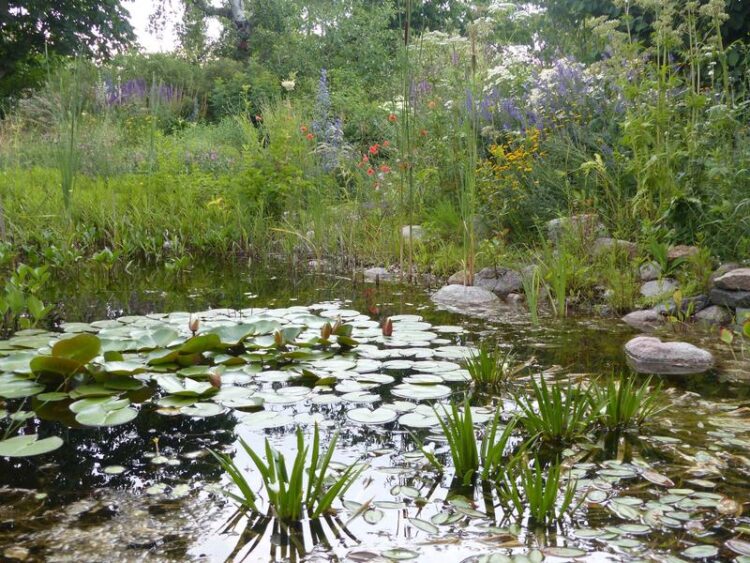Conservation gardening

Bustling wildlife around a pond. In the foreground is Stratiotes aloides L. (water pineapple), classified as vulnerable in Germany and extinct in Baden-Württemberg, thrives as a submerged aquatic native, making it an ideal choice for garden ponds.
Photo: Christian Wirth
Green spaces in Germany could contribute far more to biodiversity conservation.
Around 40 per cent of Germany’s declining and endangered native plant species could be planted in private and public green spaces, making them suitable for conservation gardening. This is the conclusion reached by researchers from the German Centre for Integrative Biodiversity Research (iDiv) and Leipzig University, who have collected the latest data on endangered Red List species in all 16 of Germany’s federal states. Their findings have now been published in the journal Scientific Reports. The data collected has been used to develop an app that provides the public with lists of plants suitable for conservation gardening in each federal state.
About 70 per cent of our flora is in decline, while 30 per cent is threatened. According to opinion polls conducted by the German Federal Agency for Nature Conservation (BfN), public willingness to tackle this biodiversity crisis is growing. “New approaches are needed that no longer view humans and biodiversity as separate aspects,” says Dr Ingmar Staude from Leipzig University.
A garden scene featuring a “carnation hill” adorned with Viscaria vulgaris Bernh. (clammy campion), classified as near threatened in Germany and Silene nutans L. (Nottingham catchfly), classified as near threatened in Saxony. Photo: Christian Wirth
Germany’s millions of gardens have enormous potential to get people involved in conservation. This could be done by planting native species that are in decline alongside traditional garden plants. Until now, however, it has been unclear how many of these declining species are actually suitable for garden use, and to what extent they are currently commercially available.
For their survey, the researchers used data from the websites of plant and seed companies to assess the commercial availability of the listed species. Based on this, they created an app that provides private gardeners, conservationists and local authorities with lists of plants from which they can select suitable plants for conservation. According to Dr Ingmar Staude, the number of threatened species varies from 515 to around 1120, depending on the federal state: “We found out that in Hamburg, for example, about half of the endangered species, 352, are suitable for gardening, and in Bavaria about a third, 321 species.”
Staude adds that more than half of the threatened species are currently already commercially available: “Just under half of these plant species prefer dry soils. In the case of conventional garden plants, the figure is only around one third. Considering climate change, this is a significant finding. Conservation gardening raises public awareness of the biodiversity crisis while engaging people in action to reverse the decline of native plant species,” says Staude.
Wissenschaftliche Ansprechpartner:
Dr. Ingmar René Staude
Spezielle Botanik und funktionelle Biodiversität
Phone: +49 341 97-38587
Email: ingmar.staude@uni-leipzig.de
Prof. Dr. Christian Wirth
Spezielle Botanik und funktionelle Biodiversität
Phone: +49 341 97-38591
Email: cwirth@uni-leipzig.de
Originalpublikation:
https://www.nature.com/articles/s41598-023-39432-8
“Putting conservation gardening into practice”; DOI: 10.1038/s41598-023-39432-8
Weitere Informationen:
https://conservation-gardening.shinyapps.io/app-de/
https://conservation-gardening.shinyapps.io/app-en/
Media Contact
All latest news from the category: Ecology, The Environment and Conservation
This complex theme deals primarily with interactions between organisms and the environmental factors that impact them, but to a greater extent between individual inanimate environmental factors.
innovations-report offers informative reports and articles on topics such as climate protection, landscape conservation, ecological systems, wildlife and nature parks and ecosystem efficiency and balance.
Newest articles

Innovative 3D printed scaffolds offer new hope for bone healing
Researchers at the Institute for Bioengineering of Catalonia have developed novel 3D printed PLA-CaP scaffolds that promote blood vessel formation, ensuring better healing and regeneration of bone tissue. Bone is…

The surprising role of gut infection in Alzheimer’s disease
ASU- and Banner Alzheimer’s Institute-led study implicates link between a common virus and the disease, which travels from the gut to the brain and may be a target for antiviral…

Molecular gardening: New enzymes discovered for protein modification pruning
How deubiquitinases USP53 and USP54 cleave long polyubiquitin chains and how the former is linked to liver disease in children. Deubiquitinases (DUBs) are enzymes used by cells to trim protein…



